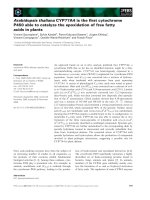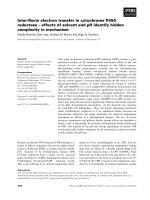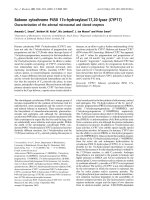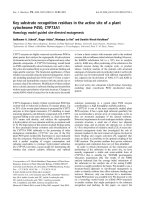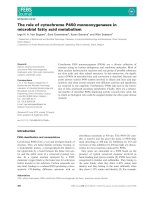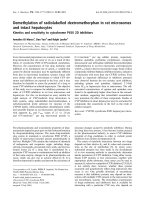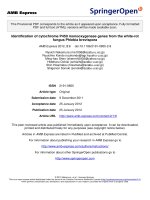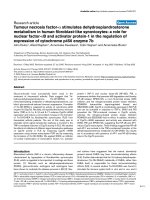modeling of anopheles minimus mosquito nadph cytochrome p450 oxidoreductase cypor and mutagenesis analysis
Bạn đang xem bản rút gọn của tài liệu. Xem và tải ngay bản đầy đủ của tài liệu tại đây (1.02 MB, 18 trang )
Int. J. Mol. Sci. 2013, 14, 1788-1801; doi:10.3390/ijms14011788
OPEN ACCESS
International Journal of
Molecular Sciences
ISSN 1422-0067
www.mdpi.com/journal/ijms
Article
Modeling of Anopheles minimus Mosquito NADPH-Cytochrome
P450 Oxidoreductase (CYPOR) and Mutagenesis Analysis
Songklod Sarapusit 1,*, Panida Lertkiatmongkol 2, Panida Duangkaew 3 and
Pornpimol Rongnoparut 2
1
2
3
Department of Biochemistry, Faculty of Science, Burapha University, Chonburi 20131, Thailand
Department of Biochemistry, Faculty of Science, Mahidol University, Bangkok 10400, Thailand;
E-Mails: (P.L.); (P.R.)
Faculty of Animal Sciences and Agricultural Technology, Silpakorn University,
Petchaburi IT Campus, Petchaburi 76120, Thailand; E-Mail:
* Author to whom correspondence should be addressed; E-Mail: ;
Tel.: +66-038-103-058; Fax: +66-038-393-495.
Received: 25 September 2012; in revised form: 19 November 2012 / Accepted: 5 January 2013 /
Published: 16 January 2013
Abstract: Malaria is one of the most dangerous mosquito-borne diseases in many
tropical countries, including Thailand. Studies in a deltamethrin resistant strain of
Anopheles minimus mosquito, suggest cytochrome P450 enzymes contribute to the
detoxification of pyrethroid insecticides. Purified A. minimus CYPOR enzyme (AnCYPOR),
which is the redox partner of cytochrome P450s, loses flavin-adenosine di-nucleotide
(FAD) and FLAVIN mono-nucleotide (FMN) cofactors that affect its enzyme activity.
Replacement of leucine residues at positions 86 and 219 with phenylalanines in FMN
binding domain increases FMN binding, enzyme stability, and cytochrome c reduction
activity. Membrane-Bound L86F/L219F-AnCYPOR increases A. minimus P450-mediated
pyrethroid metabolism in vitro. In this study, we constructed a comparative model structure
of AnCYPOR using a rat CYPOR structure as a template. Overall model structure is
similar to rat CYPOR, with some prominent differences. Based on primary sequence and
structural analysis of rat and A. minimus CYPOR, C427R, W678A, and W678H mutations
were generated together with L86F/L219F resulting in three soluble Δ55 triple mutants.
The C427R triple AnCYPOR mutant retained a higher amount of FAD binding
and increased cytochrome c reduction activity compared to wild-type and
L86F/L219F-Δ55AnCYPOR double mutant. However W678A and W678H mutations did
not increase FAD and NAD(P)H bindings. The L86F/L219F double and C427R triple
Int. J. Mol. Sci. 2013, 14
1789
membrane-bound AnCYPOR mutants supported benzyloxyresorufin O-deakylation
(BROD) mediated by mosquito CYP6AA3 with a two- to three-fold increase in efficiency
over wild-type AnCYPOR. The use of rat CYPOR in place of AnCYPOR most efficiently
supported CYP6AA3-mediated BROD compared to all AnCYPORs.
Keywords: Anopheles minimus mosquito; cytochrome P450 oxidoreductase (CYPOR);
structure; FAD and NAD(P)H bindings
1. Introduction
The reemergence of malaria, a disease transmitted to humans by mosquitoes, is associated with
vector resistance in many tropical countries due to the persistent use of pyrethroid insecticides [1,2].
The insecticide resistance has been reported in Anopheles minimus mosquito, one of the malaria
primary vectors in Thailand [3]. A common mechanism for insecticide resistance involves an elevation
in insecticide detoxification. Cytochrome P450 monooxygenases (P450) are important enzymes in
pyrethroid metabolism and have been implicated in insecticide resistance in many insects [4]. In
A. minimus, an elevated level of CYP6AA3 and CYP6P7 transcripts has been detected during selection
for deltamethrin resistance [5,6]. Heterologously expressed CYP6AA3 and CYP6P7 enzymes in an
insect-baculovirus system have shown capability to specifically metabolize type I and type II
pyrethroids in vitro [7–9].
Catalysis by P450 enzymes requires an electron supplement from NADPH-cytochrome P450
oxidoreductase enzyme (CYPOR), a membrane-bound enzyme that transfers electrons, from NADPH
to P450s via FAD and FMN cofactors [10–12]. RNA interference indicated the influential role of
mosquito CYPOR enzyme in permethrin resistance in A. gambiae, a major malaria vector in
Africa [13]. Thus, studies of CYPOR properties in A. minimus, may provide important information for
the malarial vector control program in Thailand.
The membrane-bound A. minimus CYPOR (flAnCYPOR) cDNA has been isolated and expressed in
Escherichia coli [7]. The purified flAnCYPOR enzyme can support baculovirus-expressed CYP6AA3
and CYP6P7 to metabolize pyrethroid insecticides and benzyloxyresorufin fluorescent substrate in vitro,
but the purified enzyme is prone to lose FAD and FMN cofactors compared to rat CYPOR [7–9,14,15]. In
addition, higher trypsin sensitivity of AnCYPOR indicates a more open conformation or high
flexibility of the soluble Δ55AnCYPOR enzyme compared to rat CYPOR structure. Unlike rat and
house fly CYPORs, the open/highly flexible structure of AnCYPOR could explain that AnCYPOR
loosely binds flavin cofactors and can be reconstituted with exogenous FMN and FAD in vitro [14–17].
Substitutions of leucine 86 and leucine 219 with phenylalanine in the FMN-binding domain generate a
L86F/L219F double mutant of both soluble (Δ55) and membrane-bound (fl) forms that improve FMN
retention, but remain loosely bound to FAD cofactor. Binding of FAD is not improved when
phenylalanine at 456 is replaced with the conserved alanine residue in the FAD-binding domain of the
enzyme [14,15]. The L86F/L219F mutation increases enzyme stability and turnover number without
drastically changing kinetic mechanism and substrate-binding constants, NADPH Km, and cytochrome
c Km [14,15]. Consequently, a higher catalytic efficiency of L86F/L219F-flAnCYPOR increases
Int. J. Mol. Sci. 2013, 14
1790
CYP6AA3-mediated deltamethrin degradation activity in vitro [15]. Addition of exogenous FAD
contributes to a greater increase in CYP6AA3-mediated activity supported by the wild-type and
L86F/L219F mutant flAnCYPOR enzymes. In this context, why the A. minimus CYPOR is
enormously different from rat CYPOR in stability, activity in its native form and in the ease in which
flavin cofactors are lost remains unanswered.
Recently, investigation of A. gambiae CYPOR, AgCYPOR, which shares 93% of its amino acid
sequence with A. minimus CYPOR, has indicated a loss of both FMN and FAD cofactors in the
purified AgCYPOR enzyme. Moreover, AgCYPOR binds NAD(P)H differently from human
CYPOR [18], suggesting substantially different enzymatic properties in mosquito CYPORs.
Functional analyses of mosquito and mammalian CYPOR in combination with a structural comparison
may help to explain different properties. In this study, comparative modeling of AnCYPOR was
performed and the predicted models were compared to known crystal structure of rat CYPOR [10].
Based on sequence analysis and model comparison, two residues that might affect FAD binding and
enzyme catalysis, C427 and W678, were selected to generate triple mutants, in addition to L86F and
L219F. Biochemical properties of L86F/L219F/C427R, L86F/L219F/W678A, and L86F/L219F/W678H
soluble Δ55-triple mutants and catalysis by L86F/L219F double and C427R triple membrane-bound
mutants in support of BROD mediated by CYP6AA3 were investigated. Moreover, as a primary step
to understand different properties of AnCYPOR and rat CYPOR in electron transfer to P450 partner
enzyme, we employed rat CYPOR in place of mosquito CYPOR as a redox partner enzyme of
mosquito P450 in the reconstitution enzymatic assay. Our results have contributed to an understanding
of the typical nature of mosquito CYPOR compared to rat CYPOR, and its efficacy in electron transfer
in mosquito P450-mediated metabolisms.
2. Results and Discussion
2.1. Overall Structure of AnCYPOR
A predicted AnCYPOR homology model generated using rat CYPOR as a template
(pdb code: 1JA1, [19]) was chosen based on a consensus judgment of discrete optimized protein
energy (DOPE) and residue specific all-atom probability discriminatory function (RAPDF) scores.
Figure 1 shows an oval, bowl-like 3D structure of the AnCYPOR homolog in the presence of NADP+,
FAD, and FMN. The overall AnCYPOR structure contains three structural domains including
FMN-binding, FAD/NADP+-binding, and connecting domains. The FMN, FAD and NADP(H) are
positions in the middle of the structure as found in rat CYPOR [10,19]. The model has an overall
ProSA-z score of −11.01. Ramachandran plot analysis revealed 88.7% and 0.6% of residues in most
favorable and disallowed regions, respectively (Figure S1). Three residues (V256, N503, and E506)
residing in disallowed region locate in the connecting domain which functions to bring the two flavins
together and modulate electron transfer between them [10,19,20]. The crystal structure of rat CYPOR
lacks 63 N-terminal amino acids and starts with Val64, so the corresponding first residue in
AnCYPOR is Thr64. Although structure of the membrane-binding region of AnCYPOR could not be
determined in the model, sequence alignment indicated a clear difference in membrane-binding
sequence from rat CYPOR (Figure S2).
Int. J. Mol. Sci. 2013, 14
1791
Figure 1. Homology model of wild-type Anopheles minimus CYPOR (AnCYPOR).
Wild-Type AnCYPOR model demonstrates conserved regions of the flavin
mono-nucleotide (FMN)-binding domain, the connecting domain, and the flavin-adenosine
di-nucleotide (FAD)/NAD(P)H-binding domain that are colored blue, green, and red,
respectively. The mutated positions are labeled and shown in spheres. Arrows indicate
deviations among the structures of template rat CYPOR (PDB:1JA1) (green), wild-type
AnCYPOR (blue), and double mutant AnCYPOR (yellow) in the FMN-binding domain,
the connecting domain, and the FAD/NAD(P)H-binding domain. The cofactor FMN, FAD,
and NADPH are represented by magenta, purple, and grey sticks, respectively.
Figure 2. Binding interaction with FAD in AnCYPOR. Replacement of cysteine (A) with
arginine (B) could result in more molecular interactions between the enzyme and FAD in
mutant than in wild-type AnCYPOR in correspond to interactions towards FAD previously
described in rat CYPOR [10]. Wild-Type and C427R triple mutant AnCYPOR are shown
in blue and magenta cartoons, respectively. FAD is represented by grey stick. Nitrogen,
oxygen, phosphorus, and sulfur are colored blue, red, orange, and yellow, respectively.
Superimposition of the wildtype- and L86F/L219F-AnCYPOR with rat CYPOR showed topology
differences in all domains (Figure 1). Deviations are found in one location in FMN-binding domain
Int. J. Mol. Sci. 2013, 14
1792
(77QSSGRR, the connecting loop between helix A and β-sheet 1), one in FAD-binding region
(297HKAGGR at the tip of β-sheet 8), one loop in NAD(P)H binding region (588GIINLRVA), and
411
STAPE at the tip of helix K in connecting domain. These differences may reflect enzyme properties
and conformational change during AnCYPOR catalysis compared to rat CYPOR.
2.2. Predicted FAD-Binding Region
Although replacement of two leucine residues successfully increases FMN binding, possibly
through altered topology of the loop at 77QSSGRR that superimposes well with rat structure than
wild-type AnCYPOR, the L86F/L219F-Δ55AnCYPOR remains loosely bound to FAD cofactor.
Therefore, a topology change in 297HKAGGR of L86F/L219F from wild-type AnCYPOR to that of rat
CYPOR may not affect FAD binding (Figure 1). Relative to that of rat CYPOR structure, the re-side
and the si-face of FAD ring are similarly stacked by the indole ring of W678 and the si-face by Y459
in AnCYPOR. The interaction of FAD isoalloxazine ring with side chains of S460, T475, A476 and
V474 of AnCYPOR is also similar to rat CYPOR [10]. The rest of the FAD molecule lies at the
interface between the FAD-binding domain, but polypeptide chains surrounding FAD show variable
degrees of homology with rat CYPOR (Figure 1 and supplemental Figure 2). In addition, residues
participating in stabilization of FAD binding in AnCYPOR are notably different from rat CYPOR.
Residues observed in rat CYPOR are R424, R454, T491, Y478 and V489 [10], while in AnCYPOR
they are R457, T494, Y481 and V492. The rat R424, which is important for interaction with FAD, is
missing from AnCYPOR. Instead, a Cys residue was observed at position 427 (Figure S2). The short
chain sulfhydryl-group of C427 might drastically abolish interaction with FAD, leading to a loose
binding of FAD to the enzyme (Figure 2). Recently, disruption of local H bonding with FAD
pyrophosphate moiety leading to weaker FAD binding, unstable protein, and loss of catalytic activity
has been reported in V492E and R457H two naturally occurring missense mutations of human
CYPOR [21]. Thus we replaced Cys with Arg together with L86F/L219F and generated a soluble
triple mutant (L86F/L219F/C427R-Δ55AnCYPOR). The triple mutant could increase FAD binding
about 1.5 folds of double mutant L86F/L219F-Δ55AnCYPOR, and about 1.3 folds compared to the
wild-type-Δ55AnCYPOR (Table 1). The NADPH-dependent cytochrome c reduction activity in
C427R triple mutant without supplementation of FAD was about two and four folds higher than
L86F/L219F double mutant and wild-type-Δ55AnCYPORs, respectively (Figure 3). Supplementation
with FAD reduced the difference in the cytochrome c reduction activity between the C427R triple
mutant and the double mutant. The activity of this triple mutant enzyme is about 0.5 fold of rat
CYPOR activity (51.5 μmol/min/mg) [17]. The results suggest a role of C427 in FAD binding and as a
consequence increased AnCYPOR catalysis. Supplementation of FAD could further elevate the
activity of C427R triple soluble mutant, indicating another factor might also influence FAD binding.
The absence of cytochrome c reduction activity in the reaction omitted AnCYPOR enzyme excludes
the possibility of an external electron transfer pathway to cytochrome c by exogenous flavins
(unreported data). This increase in enzymatic activity of mutant AnCYPORs upon FAD supplement
during enzyme catalysis had been reported in Y459A and V492E human mutant CYPOR enzymes that
are loosely bound to FAD [22,23]. In addition, the C427R triple mutant had similar Km values for
NADPH and cytochrome c substrates to those of L86F/L219F double mutant, but its catalytic electron
Int. J. Mol. Sci. 2013, 14
1793
transfer rate (Vmax) was approximately two folds higher (data not shown). Nonetheless Km values
of L86F/L219F double and C427R triple mutants were not substantially different from
wild-type-Δ55AnCYPOR indicating that the mutations did not significantly alter structure or
substrate binding mode of enzyme (Table 2). The Km values for cytochrome c and NADPH of
wild-type-Δ55AnCYPOR in this study is noticeably lower than that previously reported [14] due to
enzymatic assays performed in this study were in low ionic strength (0.1 M Tris pH 7.5) condition,
while in previous report the assays were at high ionic strength (0.3 M Potassium phosphate pH 7.7).
Effect of ionic strength on substrate binding of CYPOR has also been reported [11].
Table 1. Flavin content analysis of Δ55AnCYPOR.
Enzyme
FMN a
FAD a
Wild-type-Δ55AnCYPOR
0.52 ± 0.01
0.64 ± 0.03
L86F/L219F-Δ55AnCYPOR
0.97 ± 0.02
0.56 ± 0.01
L86F/L219F/C427R-Δ55AnCYPOR
0.98 ± 0.01
0.82 ± 0.02
L86F/L219F/W678A-Δ55AnCYPOR
0.96 ± 0.04
0.55 ± 0.02
L86F/L219F/W678H-Δ55AnCYPOR
0.97 ± 0.02
0.57 ± 0.04
b
Δ63AgCYPOR
0.72 ± 0.01
0.80 ± 0.01
b
Human CYPOR
0.88 ± 0.01
0.92 ± 0.02
a
Flavin content is expressed as mean ± SD for mol of flavins per mol of protein in triplicate
experiments. Standard flavin was measured and used for a plot of standard curve; b Lian et al.,
2011 [18].
Figure 3. Specific activity of Δ55AnCYPOR enzymes with cytochrome c substrate.
Specific activity is expressed as µmol of substrate reduced/min/mg of protein. Data are the
average of duplicate measurements. Protein concentration was determined using Bio-Rad
protein assay reagent and bovine serum albumin (BSA) as standard. When exogenous
cofactors were tested, 2 μM of each of exogenous flavin cofactors were added and
pre-incubated with enzyme in each assay reaction.
Int. J. Mol. Sci. 2013, 14
1794
Table 2. Kinetic constants for cytochrome c reduction under substrate saturation condition
by Δ55AnCYPOR enzymes.
Enzyme
Δ55AnCYPOR
-wt
-L86F/L219F
-L86F/L219F/C427R
-L86F/L219F/W678A
-L86F/L219F/W678H
Kinetic constant (μM) a
Cytochrome c Km
NADPH Km
27.39 ± 1.41
16.41 ± 2.22
17.92 ± 1.79
16.24 ± 1.56
18.43 ± 2.12
9.61 ± 0.30
6.49 ± 1.19
7.02 ± 1.75
3.34 ± 0.83
1.91 ± 0.44
NADH Km
8.40 ± 0.10
11.64 ± 1.44
6.67 ± 2.23
7.08 ± 2.06
7.72 ± 1.33
a
Values were obtained from substrate saturation steady-state kinetic studies in the presence of extra flavins as
described in Materials and Methods and are means ± SD from triplicate experiments.
2.3. FAD/NADPH Binding Residues in AnCYPOR
Unlike FMN- and FAD-binding regions, there is no substantial alteration among residues in their
roles in NADPH binding (R301, S597, R598, K603, Y605, T607, N636 and M637) and catalysis
(S459, C631 and D676) in AnCYPOR model structure. However, one minor difference in rotameric
conformation from rat CYPOR structure was found in NAD(P)H binding domain at the end of β-sheet
21 (678WS), located at the nicotinamide-binding site and covering the isoalloxazine ring of FAD
cofactor. This conserved tryptophan (Trp) residue has been proposed to flip and facilitate nicotinamide
binding and thus hydride transfer [10,19]. To investigate the contribution of such difference in
rotameric conformation in nicotinamide binding and catalysis of AnCYPOR, we replaced W678 with
alanine and histidine as both replacements play critical role in catalytic activity and nicotinamide
binding of human and rat CYPORs [24,25].
In contrast to C427R construct, the Ala and His replacements at W678, (L86F/L219F/W678AΔ55AnCYPOR and L86F/L219F/W678H-Δ55AnCYPOR) neither increased FAD binding nor
cytochrome c reduction activity (Table 1 and Figure 3). However, cytochrome c reduction activity was
decreased compared to L86F/L219F double mutant and C427R triple mutant. Mutations with aliphatic
(W678A) and planar (W678H) residue substitutions decreased catalytic activity to 77% and 55% of
that of L86F/L219F double mutant, respectively. The decrease in cytochrome c activity has been
reported in the W676A and W676H human CYPOR mutants that retain 5 and 22% of cytochrome c
activity, respectively [24,25]. Moreover, non-linear regression steady-state kinetic analysis using
cytochrome c as an electron acceptor in this study revealed that removal of bulky Trp residue in
W678A and W678H increased NADPH binding affinity by two- to three-fold compared to wild-type
and L86F/L219F mutant AnCYPOR enzymes, but not that to NADH (Table 2). This differs from
human CYPOR mutants in which both W676A and W676H mutants lower both NADPH Km, and
NADH Km [24,25]. Specific charge interactions of amino acid residues with 2′-phosphate of NADPH
are responsible for discrimination against binding of NADH [24]. Thus, it is conceivable that W678 is
only crucial for catalysis and NADPH binding in AnCYPOR, and not nicotinamde selectivity of
NAD(P)H and NADH substrates. Whether deviation we observed at 588GIINLRVA (Figure 1) might
involve in 2'-phosphate binding of NADPH is not known. This deviation might explain low binding
affinity of A. minimus CYPOR to 2',5'-ADP column compared to human and rat CYPOR [18,26].
Int. J. Mol. Sci. 2013, 14
1795
Values of 2'AMP Ki for AnCYPOR are four-fold higher than those for rat CYPOR, suggesting
significant differences in NAD(P)H binding property between rat CYPOR and AnCYPOR [14,15].
Low binding affinity to 2',5'ADP column has also been observed for the mosquito AgCYPOR [18]. A
two-fold higher IC50 in suppression of AgCYPOR by 2'AMP has also been reported compared to
human CYPOR [18]. It is thus speculated that W678 could affect electron transfer rate and electron
transfer activity, while dramatic change in polypeptide chain that specifically interact with NAD(P)H
such as that of 588GIINLRVA might result in low nucleotide (2',5'-ADP, 2'-AMP and NAD(P)H)
binding affinity. However, the amino acids in the 588GIINLRVA polypeptide chain are distant from
those of rat CYPOR.
Further mutational investigation of this polypeptide on nicotinamide selectivity may provide
important information that could help to understand the catalytic basis of AnCYPOR.
2.4. Electron Transfer Step Is a Rate-Limiting Step in Mosquito P450 Metabolism
As P450 catalysis requires electron supplement from CYPOR, therefore, such a mutation that
affects cytochrome c reduction activity could affect the P450-mediated oxygenase reaction
in vitro [27]. This is supported by an increased efficiency of L86F/L219F-flAnCYPOR and
L86F/L219F/C427R-flAnCYPOR mutants in supporting BROD mediated by mosquito CYP6AA3
enzyme by 2.4 and 3 times, respectively compared to wild-type (Table 3). Moreover rat CYPOR which
has higher cytochrome c reduction activity than wild-type AnCYPOR and all AnCYPOR mutants
could increase mosquito P450 activity more than wild-type flAnCYPOR by 5.5 times. These increases
in velocity by L86F/L219F, C427R mutants, and rat CYPOR had no effect on substrate binding value
(Km). The results suggest that in vitro mosquito P450 activity is an electron transfer rate dependent
reaction. In human CYPOR, the loss of FAD and FMN from its binding site caused by mutation is the
major cause of diminished P450 activity. For example, the R457H and V492E mutations at the
FAD-binding site in human CYPOR result in an impaired function of CYP17A1 (17a-hydroxylase/17,
20-lyase), CYP19A1 (aromatase) and CYP1A2 in vitro [23,28–30]. Recently, a study on heme
oxygenase I (HO-I) activity also indicated a decrease in CYPOR activity affected HO-I catalytic rate,
and rate of bilirubin formation by HO-I enzyme is CYPOR-activity dependent [31]. Detailed saturated
kinetic studies reveal that a decrease in HO-I activity is caused by a decrease in catalytic rate (Vmax),
not substrate binding (Km) of HO-I [31]. Thus, we hypothesize the high catalytic activity of the
mosquito CYP6AA3-mediated enzymatic activity found in the present study originates from a high
electron transfer rate of rat CYPOR, C427R and L86F/L219F-flAnCYPOR activity compared to that
of wildtype-flAnCYPOR enzyme. This, to our knowledge, is the first mosquito P450-mammalian
CYPOR reconstitution that is more efficient than the native mosquito P450-CYPOR complex.
Int. J. Mol. Sci. 2013, 14
1796
Table 3. The in vitro reconstitution assays of CYP6AA3 mosquito P450 with three
different CYPOR enzymes.
CYPOR constructs
wt-AnCYPOR
L86F/L219F-AnCYPOR
L86F/L219F/C427R-AnCYPOR
Rat CYPOR
CYP3AA3-mediated BROD activity
(pmole resorufin produced/min/pmol P450) a
Km (μM)
Vmax (min−1)
0.35 ± 0.02
1.90 ± 0.61
3.10 ± 0.38
0.87 ± 0.04
1.89 ± 0.53
7.36 ± 0.78
1.62 ± 0.09
1.73 ± 0.17
10.20 ± 0.37
18.55 ± 0.42
1.69 ± 0.24
17.40 ± 0.90
a
Data are average of duplicate measurements.
Cytochrome c reduction
activity (U/mg protein) a
3. Experimental Section
3.1. Materials
Flavin mono-nucleotide (FMN), flavin-adenosine di-nucleotide (FAD), cytochrome c, nicotinamide
adenosine diphosphate (NADP+), nicotinamide adenosine diphosphate reduced form (NADPH) and
phenylmethylsulphonyl fluoride (PMSF) were purchased from Sigma-Aldrich (St. Louis, MO, USA).
Isopropyl-β-D-thiogalactopyranoside (IPTG) was obtained from USB (Cleveland, OH, USA),
Ni2+-NTA affinity column from Qiagen (Valencia, CA, USA), and Bio-Rad protein assay kit from
Bio-Rad (Hercules, CA, USA). Quickchange site-directed Polymerase Chain Reaction (PCR)
mutagenesis kit was purchased from Stratagene (LaJolla, CA, USA) and was used according to the
manufacturer’s instructions.
3.2. Structure Prediction of Wild-Type and Mutant CYPOR
The amino acid sequence of wild-type A. minimus CYPOR was obtained from GenBank
(ABL75156.1) and was used to search for template using PSI-BLAST against protein structures
deposited in Brookhaven Protein Data Bank [32] for comparative modeling. Rat CYPOR-triple mutant
(PDB:1JA1, [19]), exhibiting high resolved power of 1.80 Å and sharing 55% sequence identity to
A. minimus CYPOR, was selected as the template. The first 63 residues were omitted from modeling
since the N-terminus is associated with membrane anchor and membrane portion is absent in the
template structure. Sequence alignment derived from ClustalW program of various CYPOR enzymes
with some manual adjustment is shown in supplemental Figure 2. Alignments of AnCYPOR wild-type
and mutants against the template were subsequently subjected to homology modeling using
MODELLER9v6 [33]. A set of 1000 models for wild-type and mutant AnCYPORs was independently
constructed. The cofactor FAD, FMN, and NADPH were positioned in target models as in the 1JA1
template. The most promising models of wild-type and mutant CYPORs were discriminated from
incorrectly-folded structures using DOPE [34] and RAPDF [35] scoring functions. Candidate models
were further energy minimized using AMBER ff03 all atom force field implemented in Amber10 [36]
to remove bad van der Waals contacts. Model refinement was performed using steepest descent (SD)
for 3000 iterations and followed by conjugated gradient (CG) minimizations until the energy gradient
was less than 0.05 kcal/mol. The final energy minimized models were evaluated for conformation
Int. J. Mol. Sci. 2013, 14
1797
qualities using ProSAII [37,38] and Procheck [39]. Models were visualized and displayed using
PyMOL (Schrödinger LLC, NY, USA).
3.3. Site-Directed Mutagenesis of AnCYPORs
Three amino acids were separately introduced into pET28a-L86F/L219FΔ55AnCYPOR plasmid
DNA by Quickchange PCR mutagenesis kit as described in manufacturer’s instructions to generate
triple mutants of the following substitutions: C427R, W678H and W678A. The sequences of primers
used in this experiment are listed in Table 4. The same primer set was employed to generate C427R
membrane-bound triple mutant using pTrc-L86F/L219F-flAnCYPOR plasmid DNA as template. All
of the mutations were verified by DNA sequencing and the resultant plasmids were transformed into
BL21 (DE3) E. coli cells.
Table 4. Primer used for mutagenesis study.
Constructs
C427R
W678H
W678A
Primer
sense
anti-sense
sense
anti-sense
sense
anti-sense
Sequence
5'-GGTACAAGACAGCCGCCGGAACGTAGTGCA-3'
5'-TGCACTACGTTCCGGCGGCTGTCTTGTACC-3'
5'-ACGTTACTCGGCGGACGTGCACAGCTAATCGACGGGCACA-3'
5'-TGTGCCCGTCGATTAGCTGTGCACGTCCGCCGAGTAACGT-3'
5'-ACGTTACTCGGCGGACGTGGCAAGCTAATCGACGGGCACA-3'
5'-TGTGCCCGTCGATTAGCTTGCCACGTCCGCCGAGTAACGT-3'
Mutated codons are underlined.
3.4. Expression and Purification of AnCYPOR and Rat CYPOR Enzymes
Protein expression and purification of AnCYPORs were performed as previously described [14,15],
while that of rat CYPOR followed Shen et al. (1989; [17]) with a slight modification. The E. coli C43
(DE3) carrying pIN-rat CYPOR plasmid was grown at 37 °C in TB broth containing 100 μg/mL
ampicillin until OD600 was about 0.8 and protein expression induced by addition of 0.5 mM IPTG.
Cells were allowed to grow for an additional 48 h and harvested by centrifugation at 5000× g for
15 min and resuspended in binding buffer (50 mM Tris pH 7.7, 0.1 M NaCl, 10% glycerol, and 20 mM
imidazole) containing 0.2% Triton X-100. Cells were lysed by sonication and the supernatant was
applied to a Ni2+-NTA affinity column previously equilibrated with the binding buffer. The column
was extensively washed with binding buffer followed by the same buffer containing 30 mM imidazole. The
protein was eluted by increasing imidazole concentration to 100 mM. Purity of protein was assessed by
SDS-PAGE. Pure fractions were pooled, concentrated and stored at −80 °C until use. Protein concentration
was determined by the Bio-Rad protein assay using bovine serum albumin (BSA) as standard.
3.5. Expression and Purification of CYP6AA3 from Insect-Baculovirus System
Recombinant baculovirus containing CYP6AA3 cDNA was used for protein expression in
Spodoptera frugiperda (Sf9) insect cells as previously described [7]. Briefly, Sf9 cells were infected
with the CYP6AA3 expressed virus (2.5 × 108 plaque-forming units/mL) at the multiplicities of
infection of 3. Infected cells were harvested at 70–80 h post infection and resuspended in sodium
phosphate buffer pH 7.2 containing 1 mM EDTA, 0.5 mM PMSF, 5 μg/mL leupeptin, 0.1 mM DTT,
Int. J. Mol. Sci. 2013, 14
1798
and 20% glycerol, and subjected to microsome preparation using differential centrifugation.
CYP6AA3 protein expression was observed by SDS-PAGE analysis. Total P450 content was
measured from CO-different spectrum analysis [40].
3.6. Measurement of Flavin Contents and Activity Assay
Commercial FMN and FAD were further purified by high performance liquid chromatography
(HPLC) and used for generation of a standard curve and for cofactor supplementation experiments.
Concentrations of standard FAD and FMN solutions were determined spectrophotometrically at
450 nm using extinction coefficients of 11.3 and 12.2 mM−1 cm−1, respectively. FAD and FMN
contents of each sample were measured using a fluorometric method as described previously [41]. The
Bio-Rad protein assay was utilized to determine concentration of protein using rat CYPOR as standard.
The rat CYPOR protein concentration was determined using spectrophotometric method [42]. The
CYPOR-mediated cytochrome c reduction was carried out in 0.1 M Tris-HCl buffer, pH 7.5 as
previously described [7] with minor modifications. After 1 min pre-incubation of enzyme in buffer
with 40 μM cytochrome c at 25 °C, the reaction was initiated by addition of 50 μM NADPH.
NADPH-dependent cytochrome c reduction was followed by a change in absorbance at 550 nm.
Velocities are expressed as μmol/min/mg protein. One unit of enzyme was defined as the amount of
enzyme catalyzing the reduction of 3 μmol of cytochrome c per minute under described
conditions [43]. Substrate saturation steady-state kinetic studies of cytochrome c reduction were
performed in 0.1 M Tris-Cl buffer, pH 7.5 at 25 °C in a final volume of 0.75 mL. Substrate saturation
experiments were performed by varying NADPH concentration (2, 5, 7.5, 15, 25, 50 and 100 μM) and
NADH concentration (0.3, 0.5, 1, 2, 5 and 10 mM). The reaction was started by addition of enzyme
and the initial velocity data were analyzed by non-linear regression using the Grafit 6.0 software package.
3.7. CYP6AA3-Mediated BROD Assay
CYP6AA3-Mediated benzyloxyresorufin O-dealkylation reaction (BROD) was performed in
50 mM Tris-HCl buffer pH 7.5, in a total volume of 500 μL. Microsomes containing CYP6AA3
(~25 pmole) were used and enzymatic assays were reconstituted with either the purified AnCYPOR or
rat CYPOR in the ratio of 3:1 and carried out with BR substrate (0.5, 1, 2, 4, 8 μM) as described [7].
Enzyme activity was measured with a RF-5301 PC spectrofluorophotometer (Shimadzu, Kyoto, Japan)
at λex = 530 and λem = 590 nm. The amount of resorufin product was calculated referring to the
resorufin standard curve as described in Duangkaew et al., 2011 [9]. Apparent Km and Vmax values
were estimated by non-linear regression analysis using GraphPad Prism 5 software package.
4. Conclusions
In summary, comparative modeling of AnCYPOR structure demonstrated differences in topology
arrangement of AnCYPOR enzyme compared to rat CYPOR structure. AnCYPOR overall structure is
comparable to rat CYPOR, however, numerous differences in amino acid residues and topology were
found. Detail analysis revealed major differences in FMN- and FAD/NAD(P)H binding domains that
might lead to differences in enzymatic properties and catalysis of mosquito CYPOR from mammalian
Int. J. Mol. Sci. 2013, 14
1799
CYPORs. Mutagenesis studies further indicated that C427 is critical for FAD binding in AnCYPOR.
In addition, NAD(P)H binding and catalysis of this mosquito CYPOR is remarkably different from
mammalian CYPORs. It is apparent that a low stoichiometry of FAD may not matter much in this
enzyme, at least in vitro, as FAD can be easily reconstituted into the FAD binding site of AnCYPOR.
Acknowledgments
All computations were performed on Linux high performance clusters by courtesy of Sissades
Tongsima, Biostatistics and Informatics laboratory, Genome Institute, NSTDA Thailand. This work is
financially supported by Faculty of Science, Burapha University (S.S.) and Thailand Research Fund and
Mahidol University (P.R.). We thank Frederick W. H. Beamish for criticism and reading the manuscript.
References
1.
2.
Scott, J.F. Cytochromes P450 and insecticide resistance. Insect Biochem. Mol. Biol. 1999, 29, 757–777.
Rivero, A.; Vézilier, J.; Weill, M.; Read, A.F.; Gandon, S. Insecticide control of vector-borne
diseases: When is insecticide resistance a problem? PLoS Pathog. 2010, 6, e1001000.
3. Chareonviriyaphap, T.; Aum-Aung, B.; Ratanatham, S. Current insecticide resistance pattern in
mosquito vectors in Thailand. Southeast Asian J. Trop. Med. Public Health 1999, 30, 184–194.
4. Feyereisen, R. Insect P450 enzyme. Annu. Rev. Entomol. 1999, 44, 507–533.
5. Rongnoparut, P.; Boonsuepsakul, S.; Chareonviriyaphap, T.; Thanomsing, N. Molecular cloning
and expression of cytochrome P450, CYP6P5 and CYP6AA2, from Anopheles minimus strain
resistant to deltamethrin. J. Vector Ecol. 2003, 2, 150–158.
6. Rodpradit, P.; Boonsuepsakul, S.; Chareonviriyaphap, T.; Bangs, M.J.; Rongnoparut, P.
Cytochrome P450 genes: Molecular cloning and over expression in a pyrethroid-resistant strain of
Anopheles minimus mosquito. J. Am. Mosq. Control Assoc. 2005, 21, 71–79.
7. Kaewpa, D.; Boonsuepsakul, S.; Rongnoparut, P. Functional expression of mosquito
NADPH-cytochrome P450 reductase in Escherichia coli. J. Econ. Entomol. 2007, 100, 946–953.
8. Boonsuepsakul, S.; Luepromchai, E.; Rongnoparut, P. Characterization of Anopheles minimus
CYP6AA3 expressed in a recombinant baculovirus system. Arch. Insect Biochem. Physiol. 2008,
69, 13–21.
9. Duangkaew, P.; Pet-Huan, S.; Kaewpa, D.; Boonsuepsakul, S.; Sarapusit, S.; Rongnoparut, P.
Characterization of mosquito CYP6P7 and CYP6AA3: Differences in substrate preference and
kinetic properties. Arch. Insect Biochem. Physiol. 2011, 76, 1–13.
10. Wang, M.; Roberts, D.L.; Paschke, R.; Shea, T.M.; Masters, B.S.S.; Kim, J.J.P.
Three-Dimensional structure of NADPH-cytochrome P450 reductase: Prototype for FMN- and
FAD-containing enzymes. Proc. Natl. Acad. Sci. USA 1997, 94, 8411–8416.
11. Murataliev, M.B.; Feyereisen, R.; Walker, F.A. Electron transfer by diflavin reductase.
Biochim. Biophys. Acta 2004, 1698, 1–26.
12. Paine, M.J.I.; Scrutton, N.S.; Munro, A.W.; Gutierrez, A.; Roberts, G.C.K.; Wolf, C.R. Electron
transfer partner of cytochrome P450. In Cytochrome P450: Structure, Mechanism and Biochemistry,
3rd ed.; Ortiz de Montellano, P.R., Ed.; Kluwer Academic/Plenum Publishers: New York, NY,
USA, 2005; pp. 115–148.
Int. J. Mol. Sci. 2013, 14
1800
13. Lycett, G.L.; McLaughlin, L.A.; Ranson, H.; Hemingway, J.; Kafatos, F.C.; Loukeris, T.G.;
Paine, M.J.I. Anopheles gambiae P450 reductase is highly expressed in oeocytes and in vivo
knockdown increases permethrin susceptibility. Insect Mol. Biol. 2006, 15, 321–327.
14. Sarapusit, S.; Xia, C.W.; Misra, I.; Rongnoparut, P.; Kim, J.J.P. NADPH-cytochrome
P450-oxidoreductase from the mosquito Anopheles minimus: Kinetic studies and the influence of
leu86 and leu219 on cofactor binding and protein stability. Arch. Biochem. Biophys. 2008, 477, 53–59.
15. Sarapusit, S.; Pet-huan, S.; Rongnoparut, P. Mosquito NADPH-cytochrome P450-oxidoreductase
mutation: Kinetic and role in CYP6AA3-mediated deltamethrin metabolism. Arch. Insect
Biochem. Physiol. 2010, 73, 232–244.
16. Mayer, R.T.; Durrant, J.L. Preparation of homogenous NADPH-cytochrome (P450) reductase
from house flies using affinity chromatography techniques. J. Biol. Chem. 1979, 254, 756–761.
17. Shen, A.L.; Porter, T.D.; Wilson, T.E.; Kasper, C.B. Structural analysis of the FMN binding
domain of NADPH-cytochrome P450 oxidoreductase by site-directed mutagenesis. J. Biol. Chem.
1989, 254, 7584–7589.
18. Lian, L.-Y.; Widdowson, P.; McLaughlin, L.A.; Paine, M.J.I. Biochemical comparison of
Anopheles gambiae and human NADPH P450 reductases reveals different 2′-5′-ADP and FMN
binding traits. PLoS One 2011, 6, e20574.
19. Hubbard, P.A.; Shen, A.L.; Paschke, R.; Kasper, C.B.; Kim, J.J.P. NADPH-cytochrome P450
oxidoreductase: Structural basis for hydride and electron transfer. J. Biol. Chem. 2001, 276,
29163–29170.
20. Hamdane, D.; Xia, C.; Im, S.C.; Zhang, H.; Kim, J.J.P.; Waskell, L. Structure and function of an
NADPH-cytochrome P450 oxidoreductase in an open conformation capable of reducing
cytochrome P450. J. Biol. Chem. 2009, 284, 11374–11384.
21. Xia, C.; Panda, S.P.; Marohnic, C.C.; Martasek, P.; Masters, B.S.; Kim, J.J.P. Structural basis for
human NADPH-cytochrome P450 oxidoreductase deficiency. Proc. Natl. Acad. Sci. USA 2011,
108, 13486–13489.
22. Marohnic, C.; Panda, S.; Martisek, P.; Masters, B.S.S. Diminished FAD binding in the Y459H
and V492E Antley-Bixler syndrome mutants of human cytochrome P450 reductase. J. Biol. Chem.
2006, 281, 35975–35982.
23. Kranendonk, M.; Marochic, C.; Panda, S.P.; Duarte, M.P.; Oliveira, J.S.; Masters, B.S.S.
Impairment of CYP1A2-mediated xenobiotic metabolism by Antley-Bixler syndrome variants of
cytochrome P450 oxidoreductase. Arch. Biochem. Biophys. 2008, 475, 93–99.
24. Dőhr, O.; Paine, M.J.; Friedberg, T.; Robert, G.C.; Wolf, R. Engineering of a functional human
NADH-dependent cytochrome P450 system. Proc. Natl. Acad. Sci. USA 2001, 98, 81–86.
25. Elmore, C.L.; Porter, T.D. Modification of the nucleotide cofactor binding site of cytochrome
P450 reductase to enhance turnover with NADH in vivo. J. Biol. Chem. 2002, 277, 48960–48964.
26. Sarapusit, S. The study on the NADPH-Cytochrome P450 oxidoreductase from Anopheles
minimus mosquito. Ph.D. Thesis, Mahidol Univerisity, Thailand, 2009.
27. Gomes, A.M.; Winter, S.; Klein, K.; Turpeinen, M.; Schaeffeler, E.; Schwab, M.; Zanger, U.M.
Pharmacogenomics of human liver cytochrome P450 oxidoreductase: Multifactorial analysis and
impact on microsomal drug oxidation. Pharmacogenomics J. 2009, 10, 579–599.
Int. J. Mol. Sci. 2013, 14
1801
28. Flűck, C.E.; Tajima, T.; Pandey, A.V.; Arlt, W.; Okuhara, K.; Verge, C.F.; Jabs, E.W.;
Mendonca, B.B.; Fujieda, K.; Miller, W.L. Mutant P450 oxidoreductase causes disordered
steroidogenesis with and without Antley-Bixler syndrome. Nat. Genet. 2004, 36, 228–230.
29. Pandey, A.V.; Kempna, P.; Hofer, G.; Mullis, P.E.; Flűck, C.E. Modulation of human CYP19A1
activity by mutant NADPH P450 oxidoreducatse. Mol. Endocrinol. 2007, 21, 2579–2595.
30. Palma, B.B.; Sousa, E.M.S.; Vosmeer, C.R.; Lastdrager, J.; Rueff, J.; Vermeulen, N.P.;
Kranendonk, M. Functional characterization of eight human cytochrome P450 1A2 gene variants
by recombinant protein expression. Pharmacogenomics J. 2010, 10, 478–488.
31. Pandey, A.V.; Flűck, C.E.; Mullis, P.E. Altered heme catabolism by heme oxygenase-1 caused by
mutations in human NADPH cytochrome P450 reductase. Biochem. Biophys. Res. Commun.
2010, 400, 374–378.
32. Berman, H.M.; Westbrook, J.; Feng, Z.; Gilliland, G.; Bhat, T.N.; Weissig, H.; Shindyalov, I.N.;
Bourne, P.E. The Protein Data Bank. Nucleic Acids Res. 2000, 28, 235–242.
33. Sali, A.; Blundell, T.L. Comparative protein modelling by satisfaction of spatial restraints.
J. Mol. Biol. 1993, 234, 779–815.
34. Shen, M.Y.; Sali, A. Statistical potential for assessment and prediction of protein structures.
Protein Sci. 2006, 15, 2507–2524.
35. Samudrala, R.; Moult, J. An all-atom distance-dependent conditional probability discriminatory
function for protein structure prediction. J. Mol. Biol. 1998, 275, 895–916.
36. Case, D.A.; Darden, T.A.; Cheatham, T.E.; Simmerling, C.L.; Wang, J.; Duke, R.E.; Luo, R.;
Crowley, M.; Walker, R.C.; Zhang, W.; et al. AMBER 10; University of California:
San Francisco, CA, USA, 2008.
37. Sippl, M.J. Recognition of errors in three-dimensional structures of proteins. Proteins 1993, 17, 355–362.
38. Wiederstein, M.; Sippl, M.J. ProSA-Web: Interactive web service for the recognition of errors in
three-dimensional structures of proteins. Nucleic Acids Res. 2007, 35, W407–W410.
39. Laskowski, R.A.; MacArthur, M.W.; Moss, D.S.; Thornton, J.M. PROCHECK: A program to
check the stereochemical quality of protein structures. J. Appl. Cryst. 1993, 26, 283–291.
40. Omura, T.; Sato, R. The carbon monoxide-binding pigment of liver microsome. I. Evidence for its
hemoprotein nature. J. Biol. Chem. 1964, 239, 48–54.
41. Aliverti, A.; Curti, B.; Varoni, M.A. Identifying and quantitating FAD and FMN in simple and in
iron-sulfur-containing flavoproteins. In Flavoprotein Protocols, 2nd ed.; Chapman, S.K.,
Reid, G.A., Eds.; Humana Press: Totowa, NJ, USA, 1999; pp. 9–23.
42. Voznesensky, A.I.; Schenkman, J.B.; Pernecky, S.J.; Coon, M.J. The NH2-teminal region of
rabbit CYP2E1 is not essential for interaction with NADPH-cytochrome P450 reductase.
Biochem. Biophys. Res. Commun. 1994, 203, 156–161.
43. Lamb, D.C.; Warrilow, A.G.S.; Venkateswarlu, K.; Kelly, D.E.; Kelly, S.L. Activity and kinetic
mechanism of native and soluble NADPH-cytochrome P450 reductase. Biochem. Biophys. Res.
Commun. 2001, 286, 48–54.
© 2013 by the authors; licensee MDPI, Basel, Switzerland. This article is an open access article
distributed under the terms and conditions of the Creative Commons Attribution license
( />
Supplementary Information
Figure S1. Ramachandran plot of a predicted AnCYPOR structure. The number of
residues in the plot starts from Thr64 of the AnCYPOR amino acid sequence.
PROCHECK
Ramachandran Plot
WTmin_noW
180
B
ASN 440
~b
b
VAL 193
135
b
~b
~l
90
l
Psi (degrees)
45
L
a
A
0
~a
SER 363
-45
GLU 443
-90
-135
ALA 204
~bCYS 57
~p
b
-180
p
-135
-90
-45
0
45
Phi (degrees)
~b
90
135
180
Plot statistics
Residues in most favoured regions [A,B,L]
Residues in additional allowed regions [a,b,l,p]
Residues in generously allowed regions [~a,~b,~l,~p]
Residues in disallowed regions
Number of non-glycine and non-proline residues
Number of end-residues (excl. Gly and Pro)
Number of glycine residues (shown as triangles)
Number of proline residues
Total number of residues
458
79
3
3
---543
84.3%
14.5%
0.6%
0.6%
-----100.0%
19
41
30
---633
Based on an analysis of 118 structures of resolution of at least 2.0 Angstroms
and R-factor no greater than 20%, a good quality model would be expected
to have over 90% in the most favoured regions.
Figure S2. Sequence alignment of NADPH-cytochrome P450 oxidoreductases from
various organisms. Amino acid sequences from CYPOR homologs of human
(NCBI NP_000932.3), rat (NP_113764.1), fruit fly (D. melanogaster, NP_477158.1), and
An. gambiae (AAO24765.1) were aligned with An. minimus CYPOR (ABL75156.1) and
displayed by ClustalW. The residue numbers of the sequences are shown. Identical amino
acids are represented as dashes. The regions previously reported as the binding sites of the
coenzymes are boxed.
An. minimus
MDAQAETEMPTGSVS
DEPFLGPLDIILLVCLLAGTAWYLLKGKKKENQASQFKS 54
An. gambiae
----T---V-A----
----------V---S------W---------S------- 54
D. melanogaster
H. sapiens
R. norvegicus
-ASEQTIDGAAAIP-GGG------L--VA—AV—IG--A-F-F-RSR---EEP
TR- 55
MIN-GDSHVDTSS-V-EAVAEEVSLFSMT-M—FSLIVGLLTYWF--FR----EVP
55
-GDSH-DTSA-MPEAVAEEVSLFSTT-MV-FSLIVGVLTYWFIFRK---EIP
52
S2
Figure S2. Cont.
An. minimus
YSIQPTTVNTMTMVENSFIKKLQSSGRRLVVLYGSQTGTAEEFAGRLAKEGIRYQMKGMV 114
An. gambiae
-------------------------------F---------------------------- 114
D. melanogaster
--------C-TSASD-------KA---S---F-------G--------------RL---- 115
H. sapiens
EFTKIQTL-SSVR-S--VE-MKKT—NII--F------------N--S-DAH--GMR--S 114
R. norvegicus
EFSKIQTTAPPVK-S--VE-MKKT--NII-F------------N--S-DAH--GMR--S 111
FMN
An. minimus
ADPEECNMEELLMLKDIDKSLAVFCLATYGEGDPTDNCMEFYDWIQNNDLDMTGLNYAVF 174
An. gambiae
------------------------------------------------------------ 174
D. melanogaster
------D-----Q-----N------------------A----E--TSG-V-LS------- 175
H. sapiens
-----YDLAD-SS-PE--NA-V---M-----------AQD----L-ET-V-LS-VKF--- 174
R. norvegicus
-----YDLAD-SS-PE-----V---M-----------AQD----L-ET-V-L--VKF--- 171
FMN
An. minimus
GLGNKTYEHYNKVGIYVDKRLEELGANRVFELGLGDDDANIEDYLITWKEKFWPTVCDFF 234
An. gambiae
--------------------------------------------F-------------Y- 234
D. melanogaster
-------------A-----------------------------DF----DR---A---H- 235
H. sapiens
---------F-AM-K-------Q---Q-I---------G-L-EDF---R-Q---A--EH- 234
R. norvegicus
---------F-AM-K---Q---Q---Q-I---------G-L-EDF---R-Q---A--EF- 231
An. minimus
GIESTGEDVLMRQYRLLEQPEVGADRIYTGEVARLHSLQTQRPPFDAKNPFLAPIKVNRE 294
An. gambiae
--------------------D-S------------------------------------- 294
D. melanogaster
---GG--E—I----------D-QP-------I-----I-N-------------------- 295
H. sapiens
-V-A---ESSIR--ELVVHTDID-AKV-M--MG--K-YEN-K-----------AVTT--K 294
R. norvegicus
-V-A---ESSIR--ELVVHEDMDVAKV-T--MG--K-YEN-K-----------AVTA--K 291
An. minimus
LHKAGGRSCMHVEFDIEGSKMRYEAGDHLAMYPVNDRDLVERLGKLCNADLETVFSLINT 354
An. gambiae
--------------------------------------------R----E-D-------- 354
D. melanogaster
---G-------I-LS--------D----V--F----KS---K--Q------D-------- 355
H. sapiens
-NQGTE-HL--L-L--SD--I--ES---V-V--A--SA--NQ--KILG---DV-M--N-L 354
R. norvegicus
-NQGTE-HL--L-L--SD--I--ES---V-V--A--SA--NQI-EILG---DVIM--N-L 351
An. minimus
DTDSSKKHPFPCPTTYRTALTHYLEITALPRTHILKELAEYCSEEKDKEFLRFISSTAPE 414
An. gambiae
------------------------------------------G----------------D 414
D. melanogaster
----------------------------I-------------TD—E---L--SMA-IS-- 415
H. sapiens
-EE-N---------S------Y--D--NP---NV-Y---Q-A--PSEQ-L--KMA-SSG- 414
R. norvegicus
-EE-N----------------Y--D--NP---NV-Y---Q-A--PSEQ-H-HKMA-SSG- 411
An. minimus
GKAKYQEWVQDSCRNVVHVLEDIPSCHPPIDHVCELLPRLQPRYSSISSSSKIHPTTVHV 474
An. gambiae
---------------I----------------------------H-------L------- 474
D. melanogaster
--E---S-I--A---I--I----K--R-----------------Y-----A-L---D--- 475
H. sapiens
--EL-LS--VEAR-HILAI-Q-CP-LR-----L--------A--Y--A----V--NS--I 474
R. norvegicus
--EL-LS--VEAR-HILAI-Q-YP-LR-----L--------A--Y--A----V--NS--I 471
FMN
FAD
S3
Figure S2. Cont.
An. minimus
TAVLVKYETKTGRLNKGVATTFLAEKHPNDGEP LPRVPIFIRKSQFRLPPKPETPVIMV 533
An. gambiae
--------------------------------- A------------------------- 533
D. melanogaster
-----E-K-P---I-------Y-KN-Q-QGS—EVK----V----------T--------- 533
H. sapiens
C--V-E----A--I------NW-RA-E-AGENGGRAL--M-V--------F-AT------ 534
R. norvegicus
C--A-E--A-S--V------SW-RA-E-AGENGGRAL--M-V--------F-ST------ 531
An. minimus
GPGTGLAPFRGFIQERDFSKQEGKDIGQTTLYFGCRKRSEDYIYEDELEDYSKRGIIN L 592
An. gambiae
-----------------HC-----E--------------------------------- - 592
D. melanogaster
----------------QFLRD---TV-ESI---------------S---EWV-K-TL- - 592
H. sapiens
-----V---I------AWLRQQ--EV-E-L--Y---RSD---L-RE--AQFHRD-ALTQ- 594
R. norvegicus
-----I---M------AWLREQ--EV-E-L--Y---RSD---L-RE--ARFH-D-ALTQ- 591
NADPH
NADPH
An. minimus
RVAFSRDQDKKVYVTHLLEQDSDLIWNVIGENKGHFYVCGDAKNMATDVRNILLKVIRSK 652
An. gambiae
--------E-----------------S----------I---------------------- 652
D. melanogaster
KA------G-----Q------A---------------I--------V------V-I-ST- 652
H. sapiens
N-----E-SH----Q---K--REHL-KL- -GGA-I------R---R--Q-TFYDIVAEL 653
R. norvegicus
N-----E-AH----Q---KR-REHL-KL-H-GGA-I------R---K--Q-TFYDIVAEF 651
An. minimus
GGLSETEAQQYIKKMEAQKRYSADVWS 679
An. gambiae
--------------------------- 679
D. melanogaster
-NM--AD-V------------------ 679
H. sapiens
-AMEHAQ-VD----LMTKG---L---- 680
R. norvegicus
-PMEH-Q-VD-V--LMTKG---L---- 678
NADPH
© 2013 by the authors; licensee MDPI, Basel, Switzerland. This article is an open access article
distributed under the terms and conditions of the Creative Commons Attribution license
( />
Copyright of International Journal of Molecular Sciences is the property of MDPI Publishing and its content
may not be copied or emailed to multiple sites or posted to a listserv without the copyright holder's express
written permission. However, users may print, download, or email articles for individual use.

